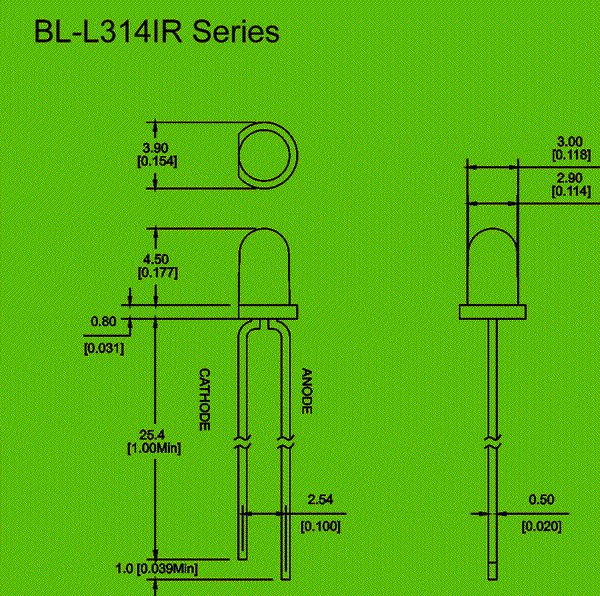3mm Infrared Emitting Diodes
Product Series information
Product Series |
|---|
 Series No:BL-L314IR Dimension 3 × 3.9 × 5.3 mm Description: ___________________________________________________________________________________________________________________________________________________ Introduction to 3mm Infrared Emitting Diodes3mm infrared emitting diodes, or IR LEDs, are miniature powerhouses of invisible light, designed to operate in the infrared spectrum. Their ability to emit light at infrared wavelengths makes them invaluable in a plethora of electronic applications, from simple remote controllers to sophisticated surveillance systems. The compact 3mm size of these diodes ensures they fit into the smallest of devices, offering flexibility and functionality in design.Features of 3mm Infrared Emitting DiodesThe core features of 3mm IR LEDs lie in their efficiency, wavelength specificity, and directional emission. These diodes are engineered to provide precise infrared output, with a focus on optimizing power consumption and maximizing output intensity. Their small form factor does not compromise their performance, making them ideal for applications requiring compact, efficient infrared light sources.Applications of 3mm Infrared Emitting Diodes3mm IR LEDs are versatile in their use, finding applications across various sectors. In consumer electronics, they are pivotal in remote controls, enabling communication with televisions, air conditioners, and other household appliances. Security systems benefit from their ability to illuminate areas without visible light, allowing for covert surveillance. Additionally, in telecommunications, these diodes facilitate infrared data transmission, offering a wireless solution for short-range communication.Benefits of 3mm Infrared Emitting DiodesThe adoption of 3mm IR LEDs in electronic designs brings numerous advantages. Their energy efficiency leads to reduced operational costs and a lower carbon footprint, while their longevity reduces the need for frequent replacements. Moreover, their small size allows for greater design flexibility, enabling the development of compact, innovative electronic devices.Case Studies: Illuminating SuccessDelving into case studies reveals the transformative impact of 3mm IR LEDs in various industries. From enhancing the user experience in consumer electronics to improving security measures in sensitive areas, these diodes demonstrate their versatility and efficiency. Each case study highlights the diodes’ contribution to technological advancements, providing insights into their practical applications.User Testimonials: In Their Own WordsUser testimonials provide a personal touch, offering perspectives from engineers, purchasers, and administrators who have firsthand experience with 3mm IR LEDs. These accounts emphasize the diodes' reliability, performance, and impact on project success, offering valuable insights into their real-world applications.Conclusion: The Future is Bright with 3mm Infrared Emitting DiodesAs we explore the capabilities and applications of 3mm infrared emitting diodes, it becomes clear that they are essential components in the progression of electronic technology. Their small size, coupled with their powerful output, makes them indispensable in a variety of applications, driving innovation and efficiency in the electronics industry. Call to Action: Embrace the potential of 3mm IR LEDs in your next project. Discover how these compact, efficient diodes can revolutionize your designs, bringing forth innovation and excellence in your electronic applications. Features
Applications
___________________________________________________________________________________________________________________________________________________ Dimension and Circuit Drawing:  |
Related Article List
Related Information
Soldering
When soldering, leave a minimum of 2mm clearance from the base of the base of the lens to the soldering point. Dipping the lens into the solder must be avoided.
Do not apply any external stress to the lead frame during soldering while the LED is at high temperature.
Recommended soldering conditions:
| IR Reflow Soldering (for SMD display) | Wave Soldering | Soldering Iron | |||
| Pre-Heat | 150-180°C | Pre-Heat | 100°C Max. | Temperature | 300°C Max. |
| Pre-Heat Time | 120sec Max. | Pre-Heat Time | 60sec Max. | ||
| Peak Temperature | 260°C Max. | SolderWave | 260°C Max. | Soldering Time | 3sec Max.(one time only) |
| Soldering Time | 10 sec Max. | Soldering Time | 5sec Max. | ||
Note: Excessive soldering temperature and/or time might result in deformation of the LED lens or failure of the LED
ESD(Electrostatic Discharge)
Static Electricity or power surge will damage the LED.
Suggestions to prevent ESD (Electrostatic Discharge):
n Use a conductive wrist band or anti-electrostatic glove when handling these LEDs
n All devices, equipment, and machinery must be properly grounded
n Work tables, storage racks, etc. should be properly grounded
n Use ion blower to neutralize the static charge which might have built up on surface of the LED’s
plastic lens as a result of friction between LEDs during storage and handling
ESD-damaged LEDs will exhibit abnormal characteristics such as high reverse leakage current,
low forward voltage, or “no light on” at low currents. To verify for ESD damage, check for “light on”
and Vf of the suspect LEDs at low currents.
The Vf of “good” LEDs should be>2.0V@0.1mA for InGaN product and >1.4V@0.1mA for AlInGaP
product.

When selecting power for LED systems, it’s essential to understand several key parameters to ensure safe operation, longevity, and optimal performance. Here are some steps and considerations for LED power selection:
- Determine the Forward Voltage (Vf) of the LED(s):
Each LED has a forward voltage, which is the voltage at which the LED operates when the current is flowing through it. This value can typically be found in the LED’s datasheet.
- Determine the Forward Current (If) of the LED(s):
The forward current is the current at which the LED is designed to operate. Running an LED at higher than its rated current can reduce its lifespan and increase the heat it produces.
- Decide on the Configuration:
Series Configuration: When LEDs are connected in series, the forward voltages add up, but the current remains the same.
Parallel Configuration: When LEDs are connected in parallel, the forward voltage remains the same, but the currents add up. This configuration can be risky because if one LED fails or has a slightly lower forward voltage, it can cause the other LEDs to draw more current.
Calculate Total Power Requirements:
Power (W) = Total Forward Voltage (V) x Total Forward Current (A)
For example, if you have three LEDs connected in series, each with a forward voltage of 3V and a forward current of 20mA, the total power requirement would be:
Power = (3V + 3V + 3V) x 20mA = 9V x 0.02A = 0.18W
- Select an Appropriate Power Supply:
- Voltage Rating: The power supply voltage should match or slightly exceed the total forward voltage of your LED configuration.
- Current Rating: The power supply’s current rating should meet or exceed the total forward current of your LED configuration.
- Safety Margin: It’s a good practice to select a power supply that can provide at least 20% more power than your calculated requirement. This ensures the power supply isn’t operating at its maximum capacity, which can extend its life and ensure safer operation.
- Consider Additional Features:
- Dimming Capability: If you want to control the brightness of your LEDs, choose a power supply with dimming capabilities.
- Overcurrent and Overvoltage Protection: To protect your LEDs, select a power supply with built-in protection mechanisms.
- Thermal Management: Ensure that the power supply has adequate cooling, especially if it will be enclosed or in a location with limited airflow.
- Regulation and Efficiency:A power supply with good regulation will maintain a consistent voltage output despite variations in the load. High efficiency ensures minimal power is wasted as heat.
- Physical Size and Form Factor:Depending on where you plan to place the power supply, its size and shape may be critical factors.
In summary, when selecting power for LED systems, understanding your LED’s requirements and the configuration you plan to use is essential. Then, pick a power supply that meets those needs with some added safety margin, keeping in mind any additional features or constraints relevant to your project.
Here are some well-regarded brands in the industry:
- Mean Well: One of the most recognized brands in the LED power supply industry, Mean Well offers a wide range of products suitable for both indoor and outdoor applications. Their units often come with features like overcurrent protection, dimming capabilities, and high efficiency.
- Tridonic: A global leader in lighting technology, Tridonic offers LED drivers and power supplies that cater to various lighting solutions, from simple setups to advanced smart lighting systems.
- Philips Advance Xitanium: Philips is a well-known brand in the lighting industry, and their Xitanium series of LED drivers are known for reliability and performance. They cater to both indoor and outdoor LED applications.
- Osram: Another giant in the lighting industry, Osram offers a range of LED drivers and power supplies suitable for various applications, including architectural and street lighting.
- LIFUD: Specializing in LED drivers, LIFUD is known for its high-quality products that cater to both commercial and residential LED lighting solutions.
- MOSO: This brand offers a variety of LED drivers, especially for outdoor and industrial applications. Their products are known for durability and performance.
- TDK-Lambda: With a history in power electronics, TDK-Lambda offers a range of power supplies and LED drivers suitable for various applications, emphasizing reliability and advanced features.
Need help?
No related products found.